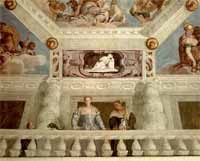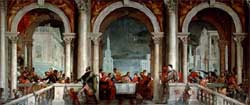Paul Caliari, known as Veronese, was born in Verona in 1528. At the time the town was strategically placed to connect Venice and Lombardy. It was a culturally stimulating place for an artist to grow up in; Veronese was apprenticed in the workshop of Antonio Badile, where other Renaissance artists, such as Giambattista Zelotti, trained. In those years important artists and intellectuals like Giorgio Vasari, arrived in Venice. Two different styles – the typically Venetian one, which preferred colours, and the Manneristic style favouring drawing from Rome and Tuscany – met.
This can be seen in Veronese’s early works, such as the Bevilacqua-Lazise altar piece, in the Castelvecchio museum in Verona, painted in about 1548; the composition of this painting is simple and the figures are evenly arranged.
Veronese became famous after painting some villas: he used false architectural elements, false stuccos, mythological figures and clever landscapes (Villa Soranza, in Treville, was an example; it no longer exists).
In 1553 he and Zelotti received a commission for painting (on canvas) allegorical subjects in the three halls of Palazzo ducale in Venice. In the panel depicting Juno giving her gifts to Venice in the Council Hall of the Ten Councillors, Veronese painted his characters in contorted positions with luminous and light colours.
In 1555 he settled in Venice where he painted man y pictures in the church of St Sebastian, including the three canvases on the ceiling depicting episodes of the life of Esther. Immediately after Veronese was asked to paint the ceiling of the Marciana Library. He painted three tondos with the allegories of Arithmetic, Music and Honour.
y pictures in the church of St Sebastian, including the three canvases on the ceiling depicting episodes of the life of Esther. Immediately after Veronese was asked to paint the ceiling of the Marciana Library. He painted three tondos with the allegories of Arithmetic, Music and Honour.
In about 1560 he worked for many noble families who commissioned frescos, portraits and, in general, paintings for private worship or for churches. He painted religious and non-religious subjects as long as they allowed him to paint scenes with lots of people, such as Feast in the house of Simon or Feast in the House of Emmaus.
Marcantonio and Daniele Barbaro commissioned the decoration of their newly built villa designed by Palladio in Maser. Veronese’s decoration included false architectural space and used light colours to make the whole decoration balanced and luminous.
He painted the Wedding at Cana for the refectory of St Giorgio Maggiore; this great canvas is now in the Louvre. There are many famous people of the time portrayed among the wedding guests.
Other than these great canvases he also painted smaller more intimate pictures, such as the dream of St Helen (London National Gallery) or the Adoration of the Magi for the church of Santa Corona in Vicenza.
In 1547 Veronese was asked to paint a large picture of the Last Supper for the refectory of  the dominican frairs of St Zanipolo. He painted a very spectacular picture, with lots of people under three great arches. The painting led to an investigation by the Inquisition which believed the numerous figures could diminish the mystical importance of the last supper. Veronese was not charged but made to change the name into Feast in the House of Levi.
the dominican frairs of St Zanipolo. He painted a very spectacular picture, with lots of people under three great arches. The painting led to an investigation by the Inquisition which believed the numerous figures could diminish the mystical importance of the last supper. Veronese was not charged but made to change the name into Feast in the House of Levi.
In the years that followed he grew famous thanks to many paintings, such as the Martyrdom of Saint Justine in the church of the Saint in Padua, the Mystic Wedding of Saint Catherine. He was called to paint the ceiling of the Council Hall in Palazzo Ducale. The subject of the scenes is Venice welcoming Justice and Peace.
In 1580 Veronese concentrated on small pictures such as Mars and Venus chained by Love and Venus and the sleeping Adonis.
His last works are more intense and colours more subdued compared to his earlier works: good examples of this mature style are Saint Anthony preaching to the Fish (Borghese Gallery of Rome), and Christ in the Garden supported by an angel in Brera.
He received an important commission for a series of paintings in the church of St Niccolò dei Frari in Venice; these paintings were scattered after the building was destroyed.
The Triumph of Venice in the Major Council Hall in Palazzo Ducale is one of his last paintings; so are Dead Christ (St Petersburg) and Miracle of St Pantaleon in the church of St Pantaleone in Venice.
Veronese died in Venice on 9th April 1588. He was sixty years old.